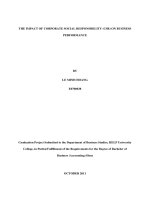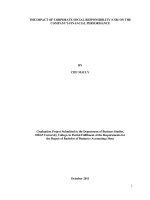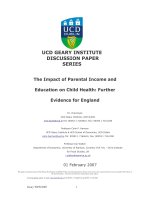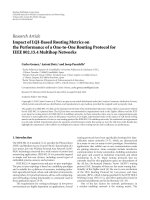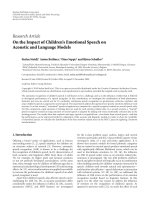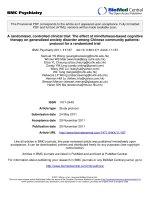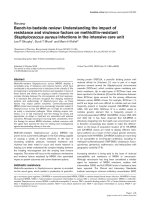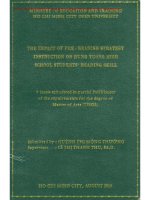the impact of task based language teaching on grammar learning at long thuong high school
Bạn đang xem bản rút gọn của tài liệu. Xem và tải ngay bản đầy đủ của tài liệu tại đây (975.84 KB, 157 trang )
MINISTRY OF EDUCATION AND TRAINING
HO CHI MINH CITY OPEN UNIVERSITY
NGUYEN THI HONG THAM
THE IMPACT OF TASK-BASED LANGUAGE TEACHING
ON GRAMMAR LEARNING
AT LONG THUONG HIGH SCHOOL
MASTER OF ARTS IN TESOL
HO CHI MINH CITY - 2019
MINISTRY OF EDUCATION AND TRAINING
HO CHI MINH CITY OPEN UNIVERSITY
THE IMPACT OF TASK-BASED LANGUAGE TEACHING
ON GRAMMAR LEARNING
AT LONG THUONG HIGH SCHOOL
MASTER OF ARTS IN TESOL
Submitted by NGUYEN THI HONG THAM
Supervisor: Dr. LE THI THANH THU
HO CHI MINH CITY - 2019
i
STATEMENT OF AUTHORSHIP
I certify that the thesis entitled “The impact of task-based language teaching
on grammar learning at Long Thuong high school”is my original work.
All sources used in this thesis have been documented. The work has not been
submitted to Open University or elsewhere.
Ho Chi Minh City, June 25th, 2019
Nguyen Thi Hong Tham
ii
ACKNOWLEDGEMENTS
I am really grateful for the help of many people who have assisted and given
me many advice as well as encouragements to complete this thesis.
First of all, I would like to express my sincere thanks to my supervisor, Dr. Le
Thi Thanh Thu for her valuable assistance. Without her help, I could not complete
this study, especially, when I was in difficulty during my nine-month pregnancy.
Secondly, I want to send my deep gratitude to my family who constantly
encouraged me whenever I lost confidence and wanted to stop due to my bad health.
Finally, I would like to thank to my colleagues as well as the participants in
two Grade 11 classes - 11A3 and 11A4 for their support and cooperation.
Ho Chi Minh City, June 25th, 2019
Nguyen Thi Hong Tham
iii
ABSTRACT
This study was conducted with the aim to investigate the impact of TaskBased Language Teaching (TBLT) on Grade 11 students’ grammar achievement
and its influence on learning motivation toward the study of English grammar at
Long Thuong high school.
Quasi-experimental was employed with the participation of two classes
divided into two groups which are the control group (CG) and the experimental
group (EG). As the sample of the study could not be chosen randomly but
conveniently, the group with lower result in the pretest was assigned as the EG and
the other was the CG. The former was taught with traditional grammar teaching
practice whereas the latter was applied task-based language teaching. Tests were
applied to measure students’ grammar achievement meanwhile Questionnaire was
utilized to investigate students’ motivation toward the learning of grammar with
TBLT.
The results revealed that TBLT had positive influence on EFL learners’
grammar achievement and their motivation in grammar learning. Results collected
from the tests indicated that though participants in the EG did not surpass the CG in
the mean score, they outperformed the CG in term of grammar’s score improvement.
Thus, the implementation of TBLT had positive effects on helping students obtain
knowledge of grammar structure. Results collected from the Questionnaire reflected
that a predominant number of participants admitted their original motivation to
learn English grammar was due to its integral role in testing and they might not
fully appreciate the role of grammar in developing other English skills. But most of
them showed their awareness of great benefits of TBLT applied in their grammar
class, and showed their interest and expectation to the new task-based grammar
class with attractive task-based activities.
Key words: Task-based language teaching (TBLT), task-based grammar, grammar
achievement, grammar learning motivation.
iv
ABSTRACT (VIETNAMESE VERSION)
Nghiên cứu này được thực hiện nhằm mục đích điều tra sự tác động của
phương pháp dạy học giao nhiệm vụ đối với thành tích học ngữ pháp và ảnh hưởng
của phương pháp này đối với động lực học ngữ pháp của học sinh khối 11 ở trường
THPT Long Thượng.
Nghiên cứu định lượng được áp dụng với sự tham gia của học sinh thuộc hai
lớp 11 tại trường THPT Long Thượng. Hai lớp này được chia ra thành hai nhóm đối
tượng nghiên cứu gồm nhóm kiểm soát (CG) và nhóm thực nghiệm (EG). Vì đối
tượng nghiên cứu không thể đươc chọn một cách ngẫu nhiên mà phải được chọn
theo một sự sắp xếp sẵn, để đảm bảo kết quả nghiên cứu có ý nghĩa, nhóm học sinh
có điểm số thấp hơn trong bài kiểm tra đầu khóa được chọn làm nhóm thực nghiệm
và nhóm còn lại với điểm số cao hơn được chọn làm nhóm kiểm soát. Trong đó
nhóm kiểm soát được học ngữ pháp bằng phương pháp truyền thống trước đây
trong khi nhóm thực nghiệm được học ngữ pháp bằng một phương pháp mới Phương pháp dạy học giao nhiệm vụ. Các bài kiểm tra đánh giá được sử dụng để đo
lường về thành tích học ngữ pháp thông qua sự tác động của phương pháp dạy học
giao nhiệm vụ, trong khi bảng câu hỏi được sử dụng để điều tra về sự tác động của
phương pháp này đối với động lực học tập ngữ pháp của học sinh
Các kết quả thống kê thu thập được cho thấy phương pháp dạy học giao
nhiệm vụ đã có tác động tích cực đến thành tích cũng như động lực học ngữ pháp
của người học trong việc học ngữ pháp tiếng Anh. Cụ thể, các kết quả thu thập được
từ các bài kiểm tra trước và sau thực nghiệm cho thấy mặc dù nhóm thực nghiệm
không vượt trội hơn nhóm kiểm soát về mặt điểm số nhưng họ đã có sự tiến bộ vượt
trội hơn về khả năng cải thiện ngữ pháp Tiếng Anh. Do đó có thể kết luận rằng việc
thực hiện phương pháp dạy học giao nhiệm vụ có ảnh hưởng tích cực trong việc
giúp học sinh lĩnh hội được các cấu trúc ngữ pháp trong Tiếng Anh. Các kết quả thu
thập được từ bảng câu hỏi cho thấy phần lớn các học sinh nhận định rằng ban đầu
v
động lực học ngữ pháp Tiếng Anh của họ bắt nguồn từ tầm quan trọng của ngữ
pháp trong các bài kiểm tra thi cử, và họ cũng chưa hoàn toàn nhận thức được vai
trò của ngữ pháp trong việc phát triển những kĩ năng Tiếng Anh khác. Nhưng sau
khi được trải nghiệm lớp học ngữ pháp bằng phương pháp dạy học giao nhiệm vụ
họ dần dần nhận ra những lợi ích tuyệt vời từ phương pháp này, từ đó cảm thấy
hứng thú và mong chờ đến giờ học ngữ pháp với những hoạt động học tập thú vị.
vi
LIST OF ABBREVIATIONS
CEFR: Common European Framework of Reference for Languages
CG: Control Group
CLT: Communicative Language Teaching
DOET: Department of Education and Training
EFL: English as a Foreign Language
EG: Experimental Group
GTM: Grammar Translation Method
L2: Second Language
MOET: Ministry of Education and Training
PPP: Presentation – Practice – Production
TBLT: Task-based Language Teaching
TESOL: Teaching English to Speakers of Other Languages
vii
LIST OF TABLES
Table 2.1 Task types................................................................................................ 15
Table 2.2 Pre-task phase’s activities........................................................................22
Table 2.3 Description of task-based language teaching framework....................... 24
Table 3.1 Description of participants.......................................................................38
Table 3.2 Grammatical structures for Grade 11...................................................... 41
Table 3.3 Teaching techniques between the CG and the EG..................................44
Table 3.4 Sample teaching plan of Unit 5............................................................... 45
Table 4.1 The Pretest’s results.................................................................................53
Table 4.2 The Posttest 1’s results............................................................................ 54
Table 4.3 Posttest 1 vs. Pretest................................................................................ 56
Table 4.4 The Posttest 2’s results............................................................................ 57
Table 4.5 Posttest 2 vs. Posttest 1............................................................................58
Table 4.6 The Posttest 3’s results............................................................................ 59
Table 4.7 Posttest 3 vs. Posttest 2............................................................................60
Table 4.8 Results of Question 1, 2, 3 ......................................................................64
Table 4.9 Results of Question 4, 5, 6, 7...................................................................67
Table 4.10 Results of Question 8, 9, 10, 11............................................................ 70
viii
LIST OF FIGURES
Figure 4.1. Test’s data analysis methodology......................................................... 51
Figure 4.2. Mean scores of two groups in the study............................................... 61
Figure 4.3. Percentage of weak students in the Pretest and Posttests..................... 62
ix
TABLE OF CONTENTS
Page
STATEMENT OF AUTHORSHIP......................................................................i
ACKNOWLEDGEMENTS ................................................................................. ii
ABSTRACT............................................................................................................ iii
ABSTRACT (VIETNAMESE VERSION)..........................................................iv
LIST OF ABBREVIATIONS ............................................................................. vi
LIST OF TABLES................................................................................................. vii
LIST OF FIGURES............................................................................................... viii
TABLE OF CONTENT.........................................................................................ix
CHAPTER 1 – INTRODUCTION
1.1. Statement of the problem................................................................................ 1
1.2. Purpose of the study........................................................................................ 4
1.3. Research questions ......................................................................................... 4
1.4. Scope of the study........................................................................................... 5
1.5. Significance of the study.................................................................................5
1.6. Background of the study................................................................................. 6
1.7. Organization of the study ............................................................................... 8
CHAPTER 2 – LITERATURE REVIEW
2.1. Grammar......................................................................................................... 9
2.1.1. Definitions of grammar.........................................................................9
2.1.2. The importance of grammar in second language learning................... 10
2.2. The history of L2 grammar teaching approaches...........................................11
2.2.1. Grammar translation method................................................................ 11
2.2.2. The direct method (DM)....................................................................... 12
2.2.3. The reading method.............................................................................. 12
2.2.4. Audiolingualism....................................................................................12
2.2.5. Communicative language teaching (CLT)........................................... 13
x
2.3. Task-based language teaching........................................................................13
2.3.1. Task....................................................................................................... 13
2.3.1.1. Definitions of task....................................................................... 13
2.3.1.2 Task types..................................................................................... 15
2.3.2. Task-based language teaching.............................................................. 18
2.3.2.1. Concept........................................................................................ 18
2.3.2.2. Principles of task-based language teaching................................ 19
2.3.2.3. Task-Based Language Teaching Framework............................. 21
2.3.2.4. Benefits of task-based language teaching................................... 25
2.3.2.5. Difficulties of task-based language teaching in Vietnam...........26
2.4. Learner motivation..........................................................................................27
2.4.1. Definitions of motivation......................................................................27
2.4.2. The importance of learner motivation.................................................. 28
2.4.3. Types of learner motivation..................................................................28
2.4.4. Learner motivation and language achievement....................................30
2.5. Previous studies.............................................................................................. 30
2.5.1. Studies related to TBLT on grammar learning in foreign
Countries..........................................................................................................31
2.5.2. Studies related to TBLT on grammar learning in Vietnam..................33
2.5.3. Implication for the present study.......................................................... 35
2.6. Chapter summary ...........................................................................................36
CHAPTER 3 – METHODOLOGY
3.1. Research setting.............................................................................................. 37
3.2. Participants......................................................................................................38
3.3. Research design.............................................................................................. 39
3.4. Experimental procedures................................................................................ 41
3.4.1. Grammar teaching procedures for the control group........................... 43
3.4.2. Grammar teaching procedures for the experimental group..................43
3.5. Data collection instruments............................................................................ 46
xi
3.5.1. The pretest ............................................................................................ 46
3.5.2. Posttests................................................................................................. 47
3.5.3. The questionnaire.................................................................................. 48
3.6. Chapter summary ...........................................................................................49
CHAPTER 4 - DATA ANALYSIS AND DISCUSSION
4.1. Data analysis methodology.............................................................................50
4.1.1. Tests.......................................................................................................50
4.1.2. Questionnaires.......................................................................................52
4.2. Research question 1’s analysis and discussions.............................................52
4.2.1. Before the treatment..............................................................................52
4.2.2. Posttest 1............................................................................................... 54
4.2.2.1. Posttest 1 between groups........................................................... 54
4.2.2.2. Posttest 1 within groups.............................................................. 55
4.2.3. Posttest 2............................................................................................... 56
4.2.3.1. Posttest 2 between groups .......................................................... 57
4.2.3.2. Posttest 2 within groups.............................................................. 58
4.2.4. Posttest 3............................................................................................... 59
4.2.4.1. Posttest 3 between groups........................................................... 59
4.2.4.2. Posttest 3 within groups ............................................................. 60
4.3. Research question 2’s analysis and discussions.............................................63
4.3.1. Students’ motivation in learning English grammar..............................64
4.3.2. Students’ recognition of the benefits of learning English grammar
with TBLT......................................................................................................66
4.3.3. Students’ attitudes toward the application of TBLT in
grammar learning............................................................................................ 69
4.4. Chapter summary............................................................................................72
CHAPTER 5 – CONCLUSIONS AND RECOMMENDATIONS
5.1. Conclusions.....................................................................................................73
5.2. Suggestions for implementation..................................................................... 75
xii
5.3. Recommendations for further study............................................................... 78
5.4. Limitations ..................................................................................................... 78
REFERENCES......................................................................................................... 80
APPENDIX A: FORM-FOCUS INSTRUCTION LESSON PLAN...................89
APPENDIX B: TBLT LESSON PLAN................................................................. 91
APPENDIX C: SUMMARY OF LESSON PLANS FOR THE CG................... 94
APPENDIX D: SUMMARY OF TBLT LESSON PLANS FOR THE EG....... 99
APPENDIX E: PRETEST.....................................................................................107
APPENDIX F: POSTTEST 1............................................................................... 111
APPENDIX G: POSTTEST 2...............................................................................115
APPENDIX H: POSTTEST 3...............................................................................119
APPENDIX I: QUESTIONNAIRE (Vietnamese version)................................ 124
APPENDIX J: QUESTIONNAIRE (English version) ......................................127
APPENDIX K: TABLES OF INDEPENDENT AND PAIR SAMPLES TTESTS......................................................................................................................130
1
CHAPTER 1 – INTRODUCTION
Being a language of internet and modernity, English is utilized by most
publications and website materials as their powerful means of communication. Thus,
the need to get as well as exchange information and experience urges people to
master this kind of dominated language. In Viet Nam, English is especially
important as it is chosen as one of the three compulsory subjects together with
Mathematics and Literature in schooling system. However, after many years
studying English at school, the English proficiency level of students is generally not
as good as expected. One of the main reason of this is due to the lack of
communicative opportunity and insufficient knowledge of linguistic elements,
especially grammar. The study is conducted with an effort to investigate the impact
of a teaching approach that can motivate and improve students’ grammar learning in
a more communicative context – Task-based language teaching.
The chapter begins with background of the study. Then statement of the
problem in which the necessity of the study is emphasized. Followed by the main
purposes of the study, the two research questions are presented in section four. The
scope and significant of the study are orderly mentioned in the last two sections of
this chapter.
1.1.
Background of the study
The study was conducted at Long Thuong high school - a small public school
in rural area of Long An province. Most of the students are local people. Since
English is not widely used in society, students rarely have chance to practice using
English outside the classroom, thus, they cannot apply what have been learned into
real communication. In addition, a large number of students are timid and not very
confident in learning and using English. Though most of them can get good grades
2
on English grammar tests, they cannot apply those that have been learned to form
their own sentences, especially for writing and speaking lessons.
Among the four teachers who are assigned to teach English at Long Thuong
high school, three of them got C1 level provided by SEAMEO RETRACT, the
other one is pursuing the Master of TESOL program at Ho Chi Minh City Open
University. All of them are young teachers who graduated from university from five
to seven years except one staff who has experienced English teaching for nearly
thirty years. Though most of the English teachers are young, they are so enthusiastic
with their teaching job and flexible in solving different educational situations.
Thanks to the solicitude of the DOET who enacts the policy of giving
interactive board to the school with the English teacher who meets the CEFR
quality standard, Long Thuong school is well equipped with two interactive boards
and two projectors which help facilitate teaching and learning process. However,
students have to move to the specialized rooms in order to experience with those
teaching and learning devices, which is considered wasting time. Normally in class,
there are many desks and chairs arranged in rows for more than 40 students in each
class and this causes difficulty for students working in pairs or in groups and
moving around.
Currently, although the MOET as well as the curriculum in textbook’s design
require the ability of students to communicate in English fluently via the applying
of communicative teaching methods, GTM with the supportive role of students’
mother tongue is mostly used to teach grammar for students at Long Thuong high
school due to the dominant role of English grammar in testing. This type of
grammar teaching method is successfully used to enhance the ability of students in
getting various strategies to deal with grammar tests as well as graduation
examination. CLT and TBLT are rarely applied because of the inconvenience of
large class size and other sensitive problems like the English proficiency of both
students and teachers. The classroom, therefore, is still dominated by teacher-
3
centered approach in which students are passive learners and passive recipients of
the knowledge given by their teachers.
1.2.
Statement of the problem
No one can deny the crucial role of both receptive and productive skills in
using a language to communicate and exchange information. However, according to
Afandi, Jufrizal, and Narius (2013), no single skills can be mastered without the
support of the others. In fact, they are like the links of a chain since each of the skill
is a prerequisite of the others. In addition, according to Yildiz and Senel (2017), the
effective use of grammar is prerequisite for the effective use of a language, which
means that language users have to be initially efficient grammar users in order to
perfectly master English’s skills. Therefore, the need to learn English grammar is
considered to be significant and necessary in the process of English learning.
According to Long (1983), grammar plays a great contribution to language
learning due to its significant effects on the rate of acquisition and the attainment of
accuracy. Sharing the same view, Afandi et al. (2013) argue a language cannot be
framed correctly without its grammar accuracy. In other word, a listener may have
difficulty in understanding speaker’s intention, or readers may misunderstand what
the writer wants to express without grammar correctness. Moreover, in Viet Nam,
grammar especially plays crucial role in the system of language testing and
assessment since a large number of national examinations greatly deal with
grammatical knowledge. However, memorizing grammatical structures with various
rules is not an easy work for many EFL learners, especially when they are not given
chance to practice using the target structures regularly in an English environment. In
addition, students’ grammar retention will be gradually fossilized due to the habit of
mechanical memorization of grammar rules and their role as passive recipients of
knowledge of grammar in a boring teacher-centered classroom. Thus, innovating
ways of teaching and learning to enhance students’ grammar achievement as well as
4
rousing their motivation toward grammar learning is especially necessary and
significant.
Many methods of grammar teaching have been introduced with the aim to
foster learners’ grammar competence. Among them, it is impossible not to mention
Grammar Translation Method (GTM) which, as what to be presented in its name,
allows the translation of English written forms into learner’s mother tongue and
mostly focus on those forms in English language teaching. Though it helps to learn
grammar rules quickly and efficiently, this method has received lots of arguments
for the lack of developing learners’ communicative abilities (Chang, 2011; Takala,
2016). Also, Yule (2010) recognizes that the emphasis on L2 forms only make
students ignore how the language might be used in everyday conversation. Thus,
learners of this GTM cannot flexibly and appropriately apply those that have been
learned into daily communication. Another common grammar teaching method
which is widely applied in EFL classrooms until now is the three Ps or PPP model
(presentation - practice - production). PPP is found as a clear-cut and condensed
technique through which the main points of grammar can be taught easily (Maftoon
and Sarem, 2012). However, this model of grammar teaching has also been
criticized to have some practical problems. According to Ellis (1988) and Scrivener
(1996), teaching grammar applying PPP is time- consuming, inflexible and, thus,
impractical due to the lack of ability to deal with changing classroom situations.
Sharing the same view, Skehan (1996, as cited in Maftoon & Sarem, 2012) points
out that PPP does not reflect principles of second language acquisition since
language learning does not always occur in a “linear fashion” influenced directly by
the taking place instruction but it is a “multifaceted complex process” in which
many other factors such as learners’ cognitive and their learning characteristic are
included (p. 33). In addition, PPP is found to be helpless to students learning
process since the opportunity for communication is limited under the tight control
from teacher (Willis, 1990).
5
According to NamazianDost, Bohloulzadeh, and Pazhakh, the most important
goal of English teaching and learning is that language learners are able to use the
target language to communicate with others efficiently and successfully (2017).
Thus, the most important methodology in English teaching should be in line with
communicative language teaching (CLT). According to Nunan (2004), not only
does TBLT focus on grammatical accuracy and forms, but it also creates chances
for communication through various interaction in the target language. Nunan (1989)
defines TBLT as a way of designing teaching syllabuses which comprises a set of
communicative tasks and a way to involve learners in comprehending, manipulating,
producing or interacting in the target language. Therefore, task-based language
teaching (TBLT) which, according to Richards and Rodgers (2001), is a logical
development of CLT is believed to be one of the most effective methodologies to
deal with grammar teaching through communicative use of the target language.
Moreover, learner motivation, which is defined by Lumsden (1994) as the desire of
students to participate in their learning process, could be considered as one of the
most decisive factors in language learning since it could decide whether the student
get failure or success in his language learning. The positive influence of TBLT on
rousing students motivation in grammar learning has also been proved by various
studies not only within the country (Hanh, 2017; Lap & Trang, 2017), but all over
the world such as Turkey (Ruso, 2007), China (Lau, 2009; Huang, 2016), Iran
(Fazli, 2016; NamazianDost et al, 2017), Japan (Hougham, 2011), etc.
In Vietnam, though the core objectives of the EFL learning curriculum as well
as the requirement from the MOET take great care for developing communicative
language teaching approaches, GTM with form-focus instruction is more warmly
welcome due to the heavy focus on grammatical tests and examinations. As a result,
most of students in Vietnam still hesitate to use English to communicate with others
even after more than 10 years learning English at public schools. In respond to this
problem,
TBLT
which
focuses
both
on
grammatical
achievement
and
communicative competence is encouraged to be employed in the teaching and
6
learning of English grammar. Recently, research about the applying of task-based
language teaching on EFL learning and teaching have been greatly noticed not only
in Vietnam (e.g. Sang, 2012; Thy, 2017; Lap & Trang, 2017; Hanh, 2017; etc.) but
also all over the world (e.g. Prabhu, 1987; Skehan, 1996; NamazianDost et al., 2017,
etc.). However, the effect of task-based language teaching on grammar learning has
not been deeply investigated in Long An province. Noticeably, at Long Thuong
high school, where English grammar has been taught deductively without context
and communicative activities was nearly ignored, no study was conducted to
examine the effect of task-based instruction on learner motivation and consider it as
a mediating variable on enhancing both grammar achievement and communicative
competence. Therefore, the present study entitled “The impact of task-based
language teaching on grammar learning at Long Thuong high school” is conducted
with the aim to investigate the impact of TBLT on EFL learners’ grammar
achievement and its influence on learning motivation toward grammar studying of
students at Long Thuong high school in particular and in Long An Province in
general.
1.3. Purpose of the study
The study aims to investigate to what extent task-based language teaching
affects the achievement of English grammar among Grade 11 students at Long
Thuong high school. In addition, whether TBLT plays important role in improving
learners’ motivation toward grammar learning is another issue that this study wants
to seek for the answer.
1.4. Research questions
The study is guided by the two research questions below:
7
1. To what extent does task-based language teaching affect Long Thuong Grade
11 students’ grammar achievement?
2. How does task-based language teaching affect their motivation toward
grammar learning?
1.5.
Scope of the study
This study aims to investigate the impact of TBLT on grammar learning of
Grade 11 students at Long Thuong high school – a small school in Long An
Province. The number of 88 voluntary students from two classes were involved in
the study within three months of the first semester of the school year 2018-2019.
The target grammar structures being instructed followed the ones in students’
textbook, however, the new grammar points including reported speech with
infinitive, reported speech with gerund, conditional in reported speech, and
pronouns (one(s), someone, anyone, no one, everyone) were noticeably included in
the experimental process so as to better locate the effect of TBLT on grammar
learning.
1.6.
Significance of the study
According to Barnard and Viet (2010), though communicative language
teaching has been espoused as the guiding principle of national curricula in
Vietnamese schooling system, a number of Vietnamese educators are hesitative and
not ready for such a radical change from more traditional methods and approaches.
This unwillingness, according to Canh and Barnard (2009), may be due to the
strong influence of national examinations which give priority to multiple-choice
tests to assess grammatical and vocabulary accuracy but ignore the skills of
speaking and listening. Therefore, teaching grammar explicitly with form-focus
instruction is more warmly welcome than the implicit acquisition of grammatical
8
structures through communicative activities. However, getting high results in
national examinations has no meaning to the reality that a great number of high
school students cannot use English to communicate with others confidently.
As mentioned above, the effect of TBLT on grammar learning is not widely
demonstrated in the context of EFL learning and teaching in Viet Nam, especially in
rural areas of Long An Province. This study is of significance since it is an attempt
to investigate the effect of using task-based activities on grammar learning. In
particular, the finding of this study would open a new trend in EFL teaching and
learning at Long Thuong high school that is to help teachers of English enhance
EFL learners’ grammar achievement. In addition, the positive influence of TBLT on
grammar learning would be helpful for English teachers in solving the issue of how
to motivate EFL learners in learning English grammar as well as other English skills.
Moreover,
based on the finding of this study, it is concluded that TBLT is
specifically beneficial for weak levels students in improving their grammatical
achievement since there was no weak students at all after task-based grammar class.
1.7.
Organization of the study
The study includes five chapters. The Introduction chapter which comprises
seven distinguished sections: background of the study, statement of the problem,
purpose of the study, research questions, scope, significance, and organization of
the study are presented in Chapter 1 - Introduction. Chapter 2 is Literature review
which explains and demonstrates the theoretical framework of the study. In this
chapter, concepts about grammar, task, task-based language teaching are also
clarified. Chapter 3 is Methodology which involves a brief description of research
setting, participants, research design, experimental procedure, data collection
instrument, and data collection and analysis procedure. Chapter 4 is Data analysis
and discussion. In this chapter, the findings drew from the experimental research
and data collected from questionnaire are analyzed and discussed so that the
9
recommendation for further research about the application of task-based language
teaching on grammar learning are presented in Chapter 5 – Conclusions and
recommendations.
10
CHAPTER 2 – LITERATURE REVIEW
As being mentioned in the previous chapter, Long Thuong high school
students have difficulty in using English for communication. In addition, they really
need to master English grammar to deal with grammatical tests responding to the
requirement of Vietnamese language testing and assessment. TBLT is supposed to
be an ideal teaching approach that helps students not only study English grammar
but also use the target structures to communicate with others confidently and
effectively. In addition, many researchers have proved that TBLT also has a good
impact on enhancing learners’ motivation in English learning. In order to enable
students to obtain both grammar and communicative competence via the application
of TBLT on grammar learning, it is necessary to examine the theoretical framework
which serves as a basis for establishing conceptual framework for the study.
Therefore, Chapter 2 - Literature review, which considers characteristics related to
grammar, task - based language teaching, and learning motivation are introduced in
this part. The empirical research are also included in this chapter as the evidence for
the positive impacts of TBLT on grammar learning that has been studied previously.
2.1. Grammar
2.1.1. Definitions of grammar
The term “grammar” has been well defined by researchers and linguists.
Celce-Murcia & Hilles (1988) defines grammar as a linguistics field that involves
“a subset of language rules which govern the configurations that the morphology
and syntax of a language assume” (p. 16). Differently, Ur (1988) and Penny (2000)
emphasize both form and meaning of a sentence by stating that grammar is a set of
rules that define how words are put together to form acceptable units of meaning
within a language. In addition, Ur also strongly expresses that a learner who knows
11
grammar is one who has mastered and can apply grammatical rules to
communicative activities in what would be considered acceptable language form (as
cited in Nhu, 2012). Richards, Platt and Platt’s also consider both meanings and
functions of sentences within the language system. Concretely, grammar, in their
view, is defined as a description of the language structure and the way in which
linguistic units such as words and phrases are formed to produce meaningful
sentences within the language (Richards, Platt & Platt, 1992).
In sum, all these definitions share the same point that grammar plays a crucial
role in the process of language achievement as it consists of rules that language
users must follow so as to be able to achieve both receptive and productive
language skills such as reading, listening, speaking, and writing. In other word, the
grammar of a language emphasizes the importance of both forms and meaning of
this language under contexts.
2.1.2. The importance of grammar in second language learning
The importance of grammar on second language acquisition has been proved
by many linguists and researchers.
Arnold (1994) confirms the importance of grammar as a skeleton on which
other language skill like reading, speaking, listening and writing are enhanced and
developed. In other word, without grammar correctness, readers can misunderstand
or have difficulty in understanding writer's intention, and listeners may be in trouble
understanding the content of speaker’s talks.
Moreover, it has been found that grammar construction greatly contributes to
language learning due to its significant effects on the rate of acquisition and the
attainment of accuracy (Long, 1983). To support for those assertions, Duckart (1995)
stated people cannot confidently produce or analyze good writing without
understanding the rules that govern it or the terms being used to discuss it, and “the

